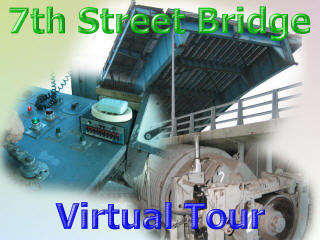
Uncredited photos on this page taken by: Nathan Holth. Unless stated in a caption, all photos are Copyright with All Rights Reserved. Learn about reuse of our photos.
![]()

![]()
This is the main control panel for the bridge, located in the control room at the top floor of the bridge tender house. The meter on the far right shows how high the bridge is, in degrees. The wooden-handled crank near the meter is the speed control for the lifting of the bridge. It is what the bridge operator turns to raise the bridge. Two of the three switches in the front of the top of the control panel lower the gates for the northern end of the bridge, and the remaining switch unlocks the bridge so it can be raised. The little silver button on the top of the side of the panel sounds the buzzer to let cars, boats, and people know the bridge is going up or down. The other meters and switches deal with motor speed, and the status of different things. A microphone for the megaphone can be seen on the wall.
![]()
Control panel details.
![]()
This small control panel, at the opposite end of the control room, is for raising and lowering the gates at the south end of the bridge. Is is located over here so that the bridge tender can look out the window and visually verify that the gates have successfully been lowered or raised.
![]()
The is a picture of the control panel as the bridge goes up. Notice how the bridge operator is using the lever to control the speed of the bridge as it goes up. Also note the degrees on the meter.
![]()
View out the window as the bridge is going up. Also note the cars being held up at the bridge: perhaps they were wondering why the bridge was going up when there were no boats!
![]()
Bridge tender operating the bridge.
![]()
Views out the window with the bridge lowered.
![]()
Located in the electrical equipment level, which is below the control room, these are the pair of motors that do the work of lifting the bridge.
![]()
Additional views of the electrical equipment level.
![]()
This is the big electrical panel under the bridge. As the bridge goes through the different stages of raising and lowering, these old fashioned electrical/mechanical switches noisily clack on and off.
![]()
The trunnion of the bridge, located in the lower level of the bridge. The 7th Street bridge is a fixed trunnion bascule bridge, which means that the whole leaf of the bridge rotates around a massive axle, called a trunnion, which stays in the same place the whole time.
![]()
Large gear for operating the bridge.
![]()
The massive concrete wall to the right is actually the counterweight for the bridge. The counterweight balances the bascule leaf, making the job of lifting the bridge much easier for the motors. When the bridge is raised, the counterweight lowers into a tail pit, which is directly below the counterweight as seen here.
![]()
Additional details at the lower level of the bridge.
![]()
![]()
![]()